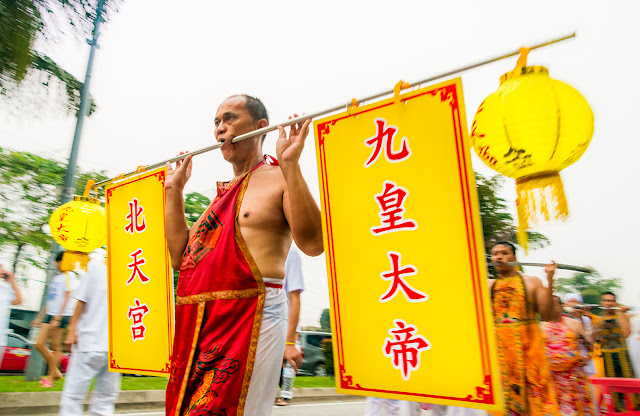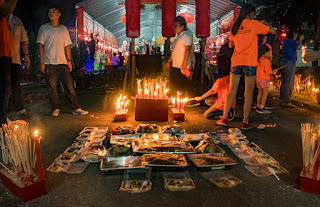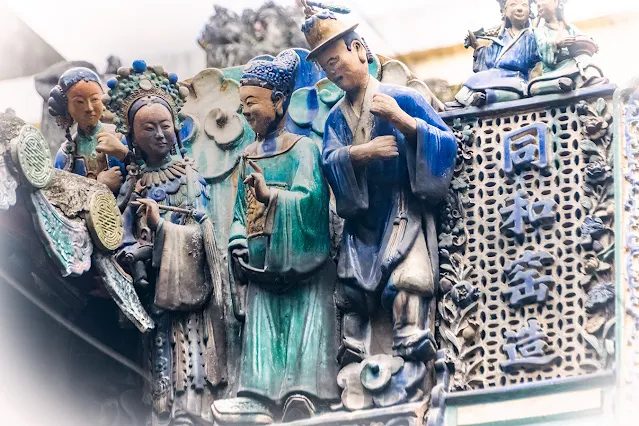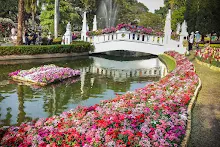A photoblog of stories, events, culture and travel. Let the images tell you what I see.
Wednesday, September 25, 2019
Counting down to Nine Emperor Gods Festival 2019
Tuesday, September 24, 2019
Let the spirits descend - the Nine Emperor Gods Festival 2019
The Nine Emperor Gods festival, which is starting is 5 days time, is associated with spirit mediums and trances of various deities including those of the Nine Emperor Gods. With these trances, acts of self mortification such as blood letting and body piercing are signs that the divine has taken over the body of the medium and that he or she does not feel any pain. Furthermore the blood letting is also both a sacrifice and purification of the space and surroundings, and thus is often carried out with great spiritual fervor. So let the spirits descend....
Where (can I see this festival): Nine Emperor Gods temples in South East Asia
For those who are looking for the schedule of events at Ampang Nine Emperor Gods Festival, surf over to Cheryl's post in her site - Haze Move over! Dates for the 2019 Festival (Ampang Style) for the schedule and lots more info regarding the festival.
Monday, September 23, 2019
Ready to sek zhai (吃斋/gin je)? The Nine Emperor Gods Festival 2019
Conversely, after nine days of festivities, the flag pole and the armies of heavenly guardians called to protect the temple and devotees during the festival would be sent off on the tenth day of the festival, one day after the last day of the Nine Emperor Gods festival.
This year the first day of the festival falls on 29 September 2019 and the ninth day falls on the 7 October 2019. The most obvious signs that a temple is celebrating the festival are temple flags being erected on roads leading to the temple grounds as well as vegetarian food stalls being erected. These stalls that sell suitable bland vegetarian food are usually marked with yellow banners displaying the word zhai/斋 or su/素; or in Southern Thailand, je/เจ.
- When (does it start): 29th Sept 2019 to 7th October 2019 (the eve falls on 28th Sept)
- Where (can I see this festival): Nine Emperor Gods temples in South East Asia
- What (to do): Eat vegetarian, see mediums perform rituals, watch parades, fire walking etc.
Saturday, August 03, 2019
Be Spirited Away - Hungry Ghost Festival
This includes the symbolic act of Breaking the Walls of Hell (Hell is a paper fort with flimsy paper doors!!) by the priest and the sprinting of the deceased from Hell by their relatives to a ship waiting to set sail for Western Paradise.
In some places, spirit mediums and trance sessions are part of the festival.
6. The Big Burn aka Sending Off the Deities and Spirits
All the paper effigies, unburnt joss sticks, candles, offerings plus lots of joss money are piled up and set on fire to return the King of Hades and his retinue back to where they belong as well as to send the deceased to heaven.
Thursday, May 02, 2019
Thursday, February 14, 2019
Lighting Up Kek Lok Si Temple for Chinese New Year
 |
| The lights of Kek Lok Si Temple in the blue hour during Chinese New Year |
The lights of the temple will come on with the following schedule:
- January 24 to February 8 2019 : 7.30pm till midnight
- February 9 to February 21 2019: 7.30pm till 10pm
In my opinion, the best times are during the blue hour, which last only 15min or so, plus at that time, the lights are just being turned on in stages, so you will probably have at most 10 mins to shoot the lights in the blue hour. It is best to go before dark and sort of scout out which angle you prefer, and you might need to go on several occasions to get a good sky. I was lucky to get some clouds this time around.
Friday, January 18, 2019
Friday, January 11, 2019
Colourful Festivals of Malaysia - Thaipusam
 |
| A female devotee rolling on the ground until the steps of the caves as part of her penance. Helping her along the way are her family members. |
In Penang, there are many locations where the devotees are pierced. The market area of Lorong Kulit (behind the city stadium) is where the large kavadis are placed onto the devotees and a good place to catch glimpses of those scary piercings.
Sunday, November 25, 2018
Loy Loy Krathong...
 วันเพ็ญเดือนสิบสอง
วันเพ็ญเดือนสิบสองน้ำก็นองเต็มตลิ่ง
เราทั้งหลายชายหญิง
สนุกกันจริงวันลอยกระทง
ลอย ลอยกระทง
ลอย ลอยกระทง
ลอยกระทงกันแล้ว
ขอเชิญน้องแก้วออกมารำวง
รำวงวันลอยกระทง
รำวงวันลอยกระทง
บุญจะส่งให้เราสุขใจ
บุญจะส่งให้เราสุขใจ
wan pen deuan sìp sŏng
náam gôr nong dtem dtà-lìng
rao táng lăai chaai yĭng
sà-nùk gan jing wan loy grà-tong
loy loy loy grà-tong
loy loy loy grà-tong
loy grà-tong gan láew
kŏr chern nóng gâew òk maa ram wong
ram wong wan loy grà-tong
ram wong wan loy grà-tong
bun jà sòng hâi rao sùk jai
bun jà sòng hâi rao sùk jai
Tuesday, October 09, 2018
Welcoming the Nine Emperor Gods @ Ampang
 |
| Going out to get the Nine Emperor Gods.... |
 |
| Here come the Nine Emperor Gods... escorting the urn back to the temple. |
Monday, October 08, 2018
The Festival begins at Ampang Nine Emperor Gods Temple
Sunday, October 07, 2018
Time for Nine Emperor Gods Festival 2018
Sunday, August 05, 2018
The View from Above - The Black Virgin Mountain
The Black Virgin Mountain or Núi Bà Đen in Tây Ninh Province of Vietnam is the highest peak in Southern Vietnam. The hill is actually an almost perfect cinder cone of an extinct volcano (which gives it its distinctive shape) and is a popular tourist spot. You can take the gondola up the hill and then opt to take the more exhilarating luge ride back down. The upper gondola station gives you a lovely view of the plains below.
 |
| View from the top station of the Núi Bà Đen gondola lift. |
Friday, August 03, 2018
Thursday, August 02, 2018
Timeless Charm of Bà Thiên Hậu (Thien Hau Temple) in Saigon
If you are in District 5 of of Saigon, do make it a point to see the Thien Hau Temple there. Officially known as Chùa Bà Thiên Hậu (Pagoda of the Lady Heaven Empress aka Mazu), the temple is quintessentially Chinese in architecture. Whilst there are many Mazu temples elsewhere around the world that are bigger, or more grand, this temple is unique as it has that old school charm typical of Chinese diaspora temples.
Look at the roof ceramic diorama, the altar decorations and setup, and donation slips being hung in the temple, and you get transported back in time to when the temple was possibly the grandest ever built at that time in that area and was the focal point of the Chinese community in Saigon. Indeed this is one of the many temples that carries the timeless charm of old Saigon, Vietnam.
Thursday, May 03, 2018
Nature's Revenge... The Forlorn Remains of Danushkodi's St Anthony Church
 |
| The front facade of the church ruins. |
Tuesday, February 06, 2018
The Colours of Spring... Chiang Mai Flower Festival
 |
| The colours of spring...tulips at Chiang Mai Flower Festival 2018 |
Sunday, March 26, 2017
Weaving by the Sea
 |
| Weaving by the sea - with a view of the seafront at Galle. |
 |
| Using strips of the coconut spathe (flower stalk sheath) as twine to bind the basket. |
Wednesday, March 15, 2017
Everlasting Flower Lady of Ooty

Sunday, February 26, 2017
I Feel Pretty...
 |
| Shot at 38mm, ƒ/6.3, 1/40s, ISO 1000 with a Nikon D5300 and Tamron AF 18-270mm F3.5-6.3 Di II VC PZD lens. |































